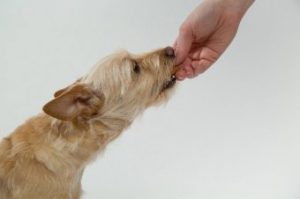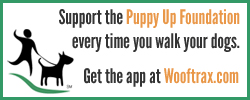
Disclaimer
The Puppy Up Foundation does not endorse nor recommend any particular product, service, or treatment. We offer information strictly for educational and/or informational purposes. We believe it is the pet owner’s responsibility to do the research and draw his or her own conclusions.
By Nancy Kerns
I realize that not everyone who reads these blog posts are Whole Dog Journal subscribers. Current subscribers have access to all back issues of WDJ, and thus, access to all of our annual reviews of dry and canned dog food, and occasional reviews of freeze-dried, dehydrated, raw frozen, and other less-common forms of dog food. Since I try to make sure that every nutrition article we publish contains unique and helpful information about feeding dogs in the safest and most healthful ways, there are lots of small facts about selecting, buying, storing, and feeding your dog that many of you might have overlooked or missed. Allow me to take the opportunity to share 10 of them with you!
- We recommend that owners switch foods frequently. Many food makers suggest switching foods slowly, by replacing a small amount of the dog’s old food with a new food and slowly increasing the percentage of new food over a week or two. If you feed more than one type of food per day to your dog, and switch frequently, you will likely find that these “slow switch” schedules are completely unnecessary. Why? Because dogs who eat a varied diet are already accustomed to a variety of foods; their bodies are already making a nice mélange of digestive enzymes that support the sort of mixed population of microbes needed to break down all sorts of foods. It’s only when you have been feeding only one type of food for a long time that you need to be so slow in introducing a new type of food.
- That said, when choosing new foods to rotate among, make sure each product offers a similar amount of fat and protein. Dog foods vary a LOT, and if you double or triple the amount of fat (in particular) in your dog’s daily diet, you can certainly trigger unwanted weight gain at the very least, and an attack of pancreatitis or worse.
- Check, too, the caloric content of the food, and keep his daily portion in a range that has been working for your dog. Some foods might contain twice as many or half as many calories per cup as other foods. Adjust the amount you feed accordingly!
- We are huge fans of adding healthy fresh foods to a dog’s diet. This can help promote a robust and varied microbiome and keep a dog from being bored stiff with his diet. Feel free to share healthy leftovers from your own meals – skipping anything that’s very high in fat (such as bacon grease, chicken skin, fat from steaks, etc). Think steamed vegetables, pasta, soup, bits of fruit, eggs, yogurt, toast crust – avoiding, of course, anything that contains ingredients to which your dog reacts poorly.
These additions shouldn’t exceed about 25 percent of your dog’s daily caloric intake. If you add fresh foods to your dog’s diet, make sure to dial back the amount of commercial food you give him accordingly, so you don’t contribute to unhealthy weight gain.
- Always check the “best by” date on any commercial product in order to buy the freshest food possible.
All foods break down over time. The fats in dry foods are subject to oxidation (which makes the fats go rancid). The vitamins degrade; microorganisms can begin to grow. All of these reactions are slower in frozen and much slower in canned food, but even these products undergo changes that affect the nutrient quality and palatability of the food over time.
Some manufacturers use only a “best by” date – the date through which the product should perform as it was intended to. Others also include a date of manufacture, which we find particularly helpful, since, otherwise, consumers are left to guess when the product was actually made.
Pet food makers designate varying periods of time past the manufacturing date of their products as the “best by” date. Dry foods that contain only natural preservatives (such as mixed tocopherols) will have shorter “life spans” than artificially preserved foods – but in any case, the fresher the food is, the closer to its date of manufacture when you buy it, the better. So while you should look for a “best by” date that is as far away as possible (indicating it is close to its date of manufacture), unless you know exactly how long that company expects its products to last, without a date of manufacture also on the label, you can’t be certain how old that food is.
Some companies, such as Wellness, state on their websites how long they expect their foods to maintain “freshness.”
- Store dry foods in their bags. We know, we know, it’s easier to scoop foods out of those nice big plastic food storage bins than out of the bag. But did you know that the fat in dry dog foods can actually interact with many plastics, and cause chemicals to leach out of the plastic and into the food? So-called “food-safe” plastics (plastics made especially to store food) are safer than any plastic not so-designated, but ALL plastics are capable of reacting with fats. In contrast, food makers keep improving the quality of the food-safe materials used to contain dry food and keep it as fresh, dry, and protected from insects as possible. Put the bag inside your plastic food bins; it will stay fresher.
- Also, keep these containers in a cool, dry place. Heat is the enemy of high-fat foods; dry dog food degrades much more quickly in high temperatures. And moisture kicks all sorts of unhealthy processes into action.
- Look at and smell your dog’s food daily, as you put it into his bowl, slow-feeder, Kongs, or what-have-you. If it looks moldy, contains anything that looks foreign (metal, plastic, insects), or smells “off,” don’t feed it! Check the “best by” and/or date of manufacture, and try to figure out what went wrong. Did you accidentally purchase an out-of-date product? Contact your retailer and perhaps also the pet food maker to report your issue (and perhaps get a refund or new product, depending on what happened).
- If your dog normally eats his food without being fussy, but suddenly declines to eat what you have fed him, DON’T “dress it up” in order to make him eat it. If he turns up his nose at the same type of food two meals in a row, examine the food more closely, smell it, check the package dates, etc. And talk to your retailer about a refund or exchange.
- If you feed your dog in a bowl every day, use a clean glass or a high-quality stainless steel bowl. These are inert materials that don’t leach harmful chemicals into the food (like plastic or low-quality ceramic bowls). Wash the bowl frequently with dish soap and hot water and allow it to dry completely. (Raw feeders should wash and dry bowls after each meal.)








